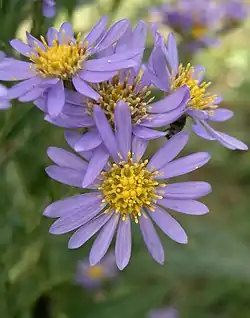紫苑
Japanese

紫苑: the aster
Alternative forms
- 紫菀 (less common)
Etymology 1
| Kanji in this term | |
|---|---|
| 紫 | 苑 |
| し Grade: S |
おん Jinmeiyō |
| on’yomi | |
From Middle Chinese 紫菀 (MC t͡siᴇX ʔʉɐnX). Compare modern Mandarin 紫菀 (zǐwǎn).
Pronunciation
Derived terms
- 紫苑色 (shion iro): a specific color coordination when wearing layered robes, usually with violet (the color of the aster) as one of the layers
Etymology 2
| Kanji in this term | |
|---|---|
| 紫 | 苑 |
| し Grade: S |
おに Jinmeiyō |
| irregular | |
Alteration from shion, where the final moraic n changed to ni.[2][3]
/ɕion/ → /ɕioni/
Pronunciation
- IPA(key): [ɕio̞ɲ̟i]
Etymology 3
| Kanji in this term | |
|---|---|
| 紫 | 苑 |
| し Grade: S |
えん Jinmeiyō |
| on’yomi | |
Alteration from shion, using the kan'on reading of en for the second character. Less common.
Pronunciation
- IPA(key): [ɕiẽ̞ɴ]
This article is issued from Wiktionary. The text is licensed under Creative Commons - Attribution - Sharealike. Additional terms may apply for the media files.